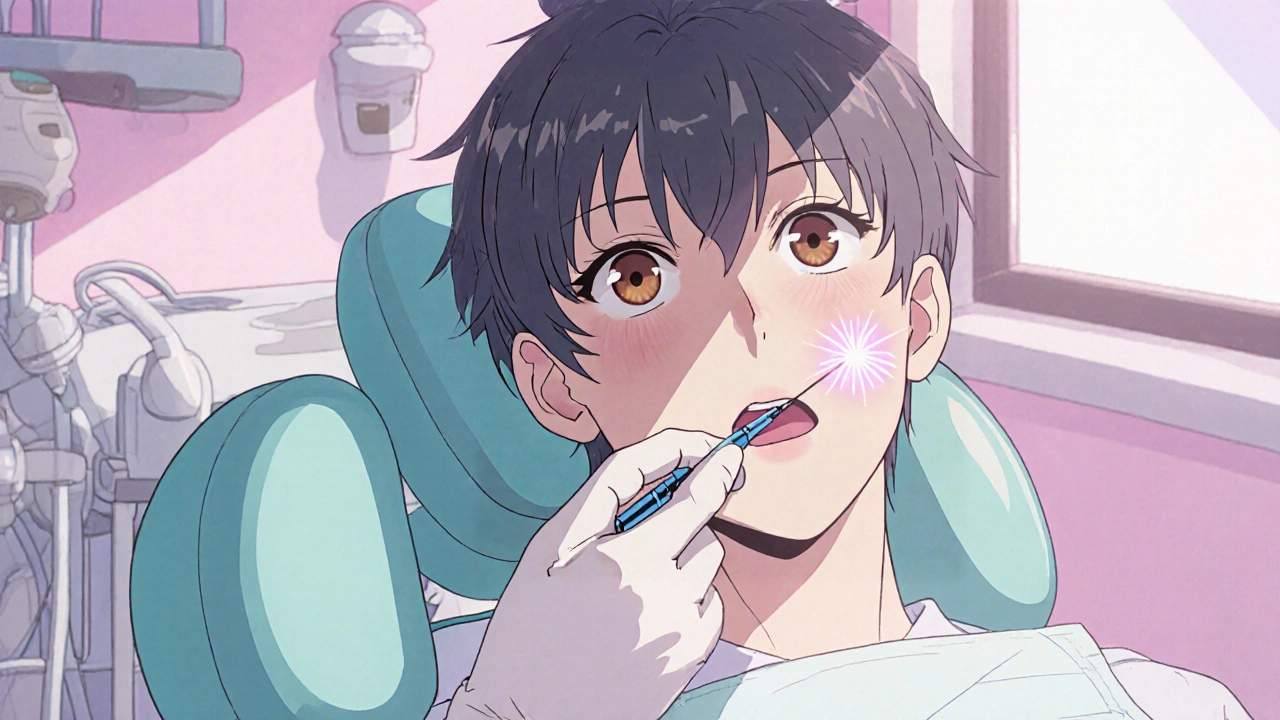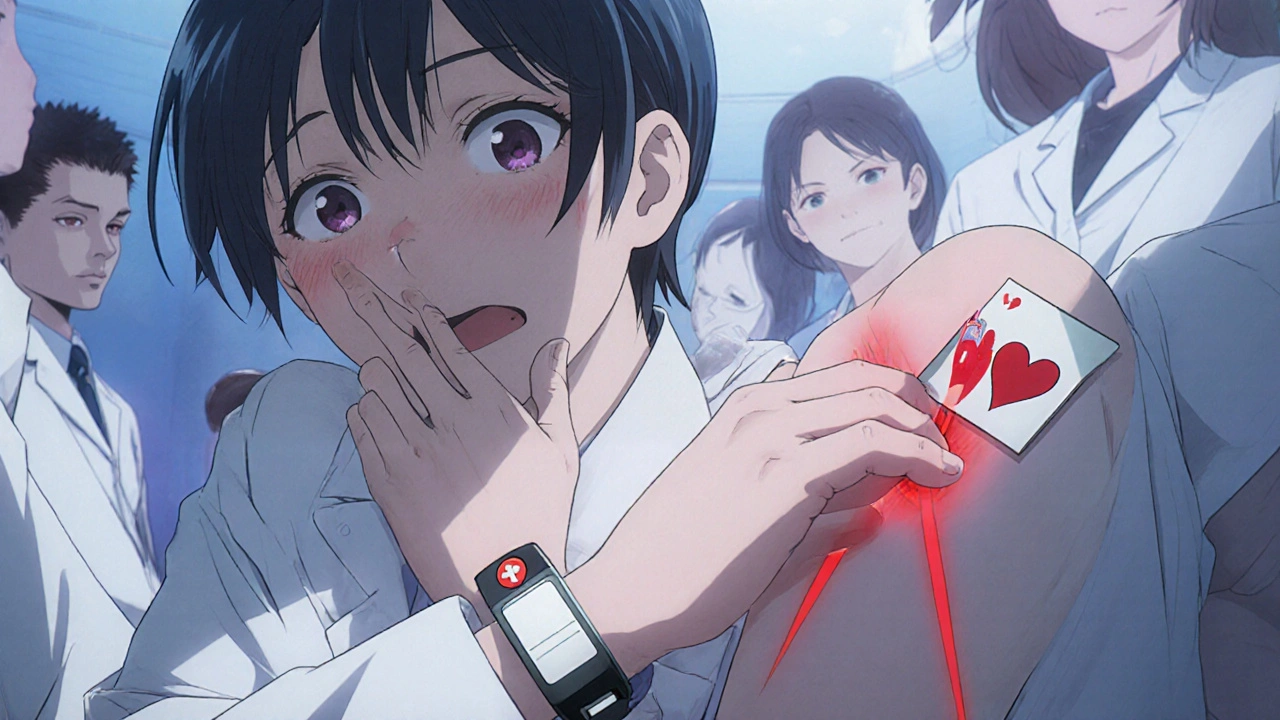Prilocaine Allergy Guide: Symptoms, Diagnosis & Treatment

Prilocaine Allergy Symptom Checker
Symptom Assessment
Select symptoms you're experiencing to determine the severity of a potential prilocaine reaction
Select symptoms to see severity assessment and recommended actions
Key Takeaways
- Prilocaine allergy is a true immune reaction, not just a side‑effect of the drug.
- Typical symptoms include skin rash, itching, swelling and, in severe cases, anaphylaxis.
- Diagnosis relies on skin prick or patch testing and careful medical history.
- Avoiding cross‑reactive local anesthetics and carrying an emergency action plan are essential preventive steps.
- Immediate medical care is required if breathing difficulty or rapid heartbeat develops.
When a dentist or surgeon uses a local anesthetic, most patients feel a dull numbness and then go about their day without a hitch. But for a small group, that harmless‑looking needle can trigger a full‑blown allergy. This guide walks you through everything you need to know about prilocaine allergy - from how it happens, to the warning signs, to the steps you can take to stay safe.
What Is Prilocaine?
Prilocaine is a medium‑acting amide‑type local anesthetic that blocks nerve signals by inhibiting sodium channels. It’s commonly used for dental procedures, minor skin surgeries, and epidural anesthesia because it causes less vasodilation than some alternatives. The drug is marketed under brand names like Citanest and is often mixed with epinephrine to prolong numbness.
How Does an Allergy to Prilocaine Develop?
Allergic reactions belong to the Type I hypersensitivity family. In a sensitized individual, the immune system produces IgE antibodies that recognize prilocaine’s molecular structure. The next time the drug is introduced, those antibodies trigger mast cells to release histamine, prostaglandins, and leukotrienes - the chemicals behind the classic allergy symptoms.
It’s worth noting that most adverse reactions to local anesthetics are not true allergies but rather toxic or pharmacologic side‑effects (e.g., methemoglobinemia). Distinguishing a genuine IgE‑mediated response from a non‑immune reaction is the first step in proper management.
Common Symptoms of Prilocaine Allergy
Symptoms can appear within minutes or up to a few hours after exposure. Below is a quick reference that separates mild, moderate, and severe manifestations.
| Severity | Typical Signs | What to Do |
|---|---|---|
| Mild | Localized itching, redness, or hives at injection site | Apply cool compress; oral antihistamine may help |
| Moderate | Widespread hives, swelling of lips or eyelids, mild wheezing | Administer oral antihistamine plus a short course of corticosteroids; seek medical advice |
| Severe (Anaphylaxis) | Rapid pulse, drop in blood pressure, difficulty breathing, throat tightness, loss of consciousness | Call emergency services immediately; use epinephrine auto‑injector if prescribed |

How Is Prilocaine Allergy Diagnosed?
Because the symptoms overlap with other drug reactions, clinicians rely on a combination of history, skin testing, and sometimes blood work.
- Medical history review: A detailed account of past surgeries, dental work, and any prior reactions helps narrow the culprit.
- Skin prick test: A tiny drop of diluted prilocaine is placed on the forearm and pricked with a lancet. A positive wheal‑and‑flare within 15 minutes suggests IgE sensitization.
- Patch test: For delayed‑type reactions, a patch containing the anesthetic is applied to the back for 48 hours. This method is less common for Prilocaine but useful when immediate test results are inconclusive.
- Serum specific IgE assay: Blood can be sent to specialized labs to measure IgE against prilocaine, though availability varies.
These tests should be performed by an allergist or immunologist in a setting equipped for emergency intervention, as false positives can still trigger anaphylaxis.
Management and Treatment Options
If a reaction occurs, the approach mirrors any other drug‑induced anaphylaxis.
- Stop the exposure: Discontinue the procedure and remove any remaining anesthetic.
- Administer epinephrine: 0.3mg intramuscularly (adult dose) into the thigh is the first‑line treatment for anaphylaxis.
- Supportive care: Provide oxygen, establish intravenous access, and monitor blood pressure and heart rate.
- Adjunct medications: Antihistamines (e.g., diphenhydramine), corticosteroids (e.g., methylprednisolone), and bronchodilators for wheezing.
- Observation: Patients should be observed for at least 4-6hours because biphasic reactions can occur.
For patients who have confirmed allergy, a written allergy label in their medical record is mandatory. Many healthcare systems use electronic health records (EHR) to flag the drug, preventing future accidental exposure.
Cross‑Reactivity with Other Local Anesthetics
Prilocaine belongs to the amide class of local anesthetics, which also includes lidocaine, mepivacaine, bupivacaine, and ropivacaine. While cross‑reactivity rates are relatively low (<10%), patients with a proven prilocaine allergy may still react to other amides.
| Drug | Typical Use | Known Cross‑Reaction Rate with Prilocaine |
|---|---|---|
| Lidocaine | Dental, minor surgery | ~5% |
| Mepivacaine | Dental infiltration | ~4% |
| Bupivacaine | Peripheral nerve block | ~2% |
| Ropivacaine | Post‑operative analgesia | ~1% |
When a safe alternative is required, many allergists recommend a ester‑type anesthetic such as procaine, which has a distinct molecular structure and virtually no cross‑reactivity with amides.

Preventive Strategies for Patients and Providers
Both sides play a role in avoiding accidental exposure.
- Patient education: Carry an allergy card or wear a medical alert bracelet that lists "Prilocaine allergy".
- Pre‑procedure screening: Dentists and surgeons should ask specifically about local anesthetic reactions during the intake questionnaire.
- Alternative drug protocols: Use ester‑type anesthetics or non‑pharmacologic numbing methods (e.g., topical benzocaine) when appropriate.
- Emergency preparedness: Clinics should stock epinephrine auto‑injectors and train staff on anaphylaxis protocols.
When to Seek Immediate Medical Help
If you notice any of the following after a procedure, treat it as an emergency:
- Sudden difficulty breathing or wheezing
- Swelling of the tongue, throat, or lips
- Rapid heartbeat, dizziness, or fainting
- Systemic rash that spreads quickly
Call 911 or go to the nearest emergency department. Even if symptoms seem mild at first, anaphylaxis can progress rapidly.
Frequently Asked Questions
Can I develop a prilocaine allergy after only one exposure?
Yes. Sensitization can happen with a single dose, especially if you have a genetic predisposition to IgE‑mediated reactions. However, many people only become allergic after repeated exposure.
Is a rash after a dental injection always an allergy?
Not always. A mild erythema can be a simple irritant response or a sign of methemoglobinemia, which is a different problem. True allergy involves itching, hives, or systemic symptoms and should be evaluated by a professional.
Do over‑the‑counter numbing gels cause the same allergic reactions?
Topical gels usually contain benzocaine or lidocaine, not prilocaine. While cross‑reactivity is rare, individuals with a broad amide‑type allergy may still react. Patch testing can clarify the risk.
How long does a positive skin prick test remain valid?
A positive result generally remains for life because IgE memory cells persist. Retesting after a negative result is only needed if clinical circumstances change.
Can I receive any local anesthetic if I’m allergic to prilocaine?
Yes, after proper allergy testing. Ester‑type agents like procaine are usually safe, and in many cases a carefully selected amide with a negative skin test can be used under close observation.
Understanding the signs, getting the right diagnosis, and having a clear action plan can turn a potentially scary reaction into a manageable situation. If you suspect a prilocaine allergy, talk to your dentist, surgeon, or primary care provider about referral to an allergist - it’s better to be safe than sorry.

Samantha Oldrid
October 17, 2025 AT 13:41Sure, because the dental industry suddenly decided to poison us with secret anesthetic conspiracies, right?
lisa howard
October 22, 2025 AT 05:41I remember the first time I walked into a dentist's office, heart pounding like a war drum, and the nurse whispered that the needle contained “magic” that would numb my soul.
Little did I know that this so‑called magic was actually a ticking time bomb of molecular mischief.
The bright lights blinded me, the sterile smell of disinfectant felt like a chemical assault, and I could sense the tension building in the air like a storm about to break.
As the anesthetic dripped, I felt a strange tingling that seemed to crawl under my skin, igniting a cascade of thoughts about hidden agendas.
The idea that a simple local anesthetic could harbor a secret identity as a covert agent of the pharmaceutical elite was both terrifying and oddly thrilling.
I imagined a clandestine meeting in some underground lab where scientists plotted to sprinkle prilocaine into every dental chart, hoping to turn patients into obedient subjects.
Each prick of the needle was like a tiny betrayal, a whisper that said, “We control your pain, and soon you’ll owe us a favor.”
The drama didn’t stop there; I began to wonder why the same drug is mixed with epinephrine, perhaps to accelerate not just numbness but also the spread of something far more sinister.
My mind raced through conspiracy theories, connecting the dots between corporate lobbying, FDA approvals, and the silent acceptance of these substances.
Yet, amidst this theatrical paranoia, I recalled the genuine relief many experience, the smiles of patients who can finally eat without agony.
It’s a paradox that the very thing that can save you from pain can also unleash a cascade of immune chaos if you’re unlucky.
The medical community, with its polished white coats, often downplays the emotional turmoil that accompanies an allergic reaction, leaving patients to navigate a maze of fear alone.
In the grand opera of healthcare, the anesthesiologists are the unsung conductors, and the allergic patient is the lone violinist caught off‑key.
So, if you ever feel that prick of fear, remember that you’re not just a victim of a drug, but a protagonist in a saga that spans molecules and mysteries.
And when the swelling subsides, the drama finally ends, leaving behind a story that will be told in hushed tones over coffee in the waiting room.
Cindy Thomas
October 26, 2025 AT 20:41While the guide correctly emphasizes the need for epinephrine in true anaphylaxis, many patients mistake a mild rash for a life‑threatening reaction 😊. In reality, distinguishing IgE‑mediated allergy from a simple irritant response often requires more than a skin prick; a comprehensive drug history is indispensable. Some clinicians even argue that routine patch testing for prilocaine is overkill, yet the literature shows it can uncover delayed hypersensitivity that would otherwise go unnoticed. Therefore, the recommendation to carry an emergency action plan is sound, but it should be tailored to the individual’s risk profile rather than applied universally. Ultimately, a balanced approach saves both anxiety and resources.
Valerie Vanderghote
October 31, 2025 AT 12:41Let me tell you, I once had a friend who thought a tiny dab of prilocaine was just a harmless numbing agent, and next thing you know she’s in the ER with a swollen face that looked like a balloon at a circus. She didn’t tell anyone because, you know, who wants to admit they’re allergic to something that’s supposed to help? So I barged into her appointment, asked the dentist every single question about the anesthetic’s composition, and even demanded to see the batch number, which, honestly, felt like I was invading their privacy. The dentist tried to be polite, but my curiosity was off the charts, and I kept pushing for details about cross‑reactivity with lidocaine and other amides, because I felt it was my duty to protect my friend. In the end, the allergist performed a skin prick test, and guess what? It was a false positive, but the whole drama taught us that sometimes the fear itself can become a self‑fulfilling prophecy. If you ever suspect a reaction, don’t sit on it; chase every clue, even if it means asking the overly‑nice nurse about the exact concentration. And yes, I know it sounds like I’m overstepping, but better safe than sorry, right?
Michael Dalrymple
November 5, 2025 AT 04:41Understanding the mechanisms behind a prilocaine allergy invites us to reflect on the delicate balance between therapeutic benefit and immunologic risk. As healthcare providers, we have a responsibility to guide patients through this terrain with both empathy and scientific rigor. Encourage individuals to document any prior reactions and to discuss them openly with their clinicians; transparency becomes the cornerstone of prevention. Moreover, fostering an environment where patients feel empowered to ask questions about cross‑reactivity can mitigate anxiety and improve compliance with emergency action plans. In this way, we not only treat the physical symptoms but also nurture the psychological resilience necessary for navigating future medical encounters.
Emily (Emma) Majerus
November 9, 2025 AT 20:41Totally get how scary this can be, keep that epi auto‑injector handy and always let your doc know you got a prilocaine reaction.
Tom Green
November 14, 2025 AT 12:41Hey folks, if you’re unsure about whether you’ve had a reaction to prilocaine, consider scheduling a consultation with an allergist who can walk you through skin testing options. It’s a collaborative process-your input about past experiences matters just as much as the test results. Together you can develop a personalized plan that includes safe alternative anesthetics and clear instructions for emergency situations. Remember, community support and shared knowledge are powerful tools in managing drug allergies.
CHIRAG AGARWAL
November 19, 2025 AT 04:41Honestly, this whole “guide” feels like it’s trying too hard to sound scientific while leaving out the real hassle of getting those tests done. Who has the time to sit through a skin prick test when you’ve got work and a life? Plus, the dentist will probably just brush it off and move on, leaving you to figure out the rest on your own.
Patricia Echegaray
November 23, 2025 AT 20:41What they don’t tell you is that the very manufacturers of prilocaine are in cahoots with global health agencies, pushing these “safe” anesthetics to keep us dependent on their products. It’s a calculated move to control our bodies, and the fact that cross‑reactivity is brushed under the rug only proves the agenda. As an American, I demand transparency and a push for home‑grown alternatives that aren’t tainted by foreign pharma conspiracies.
Miriam Rahel
November 28, 2025 AT 12:41While the article provides a commendable overview of the clinical presentation of prilocaine hypersensitivity, it regrettably omits a thorough discussion of the pharmacokinetic variations observed across different ethnic cohorts. Moreover, the assertion that epinephrine remains the unequivocal first‑line treatment fails to acknowledge recent studies suggesting adjunctive low‑dose antihistamines may attenuate biphasic responses. In sum, the exposition, though well‑structured, would benefit from a more nuanced appraisal of contemporary research.
Lauren Sproule
December 3, 2025 AT 04:41Hey all i think it’s super important to let your dentist know about any past allergic reactions even if they seemed minor its better safe then sorry
genevieve gaudet
December 7, 2025 AT 20:41From a cultural perspective, the way we perceive drug allergies is shaped by our community narratives and the stories we share about pain and healing. In many indigenous traditions, the body’s reaction to a substance is seen as a dialogue rather than a battle, prompting a holistic approach that blends medical testing with spiritual guidance. Embracing this worldview can enrich our understanding of prilocaine allergy beyond the confines of clinical protocols, fostering a more compassionate patient‑centred care.
Alexis Howard
December 12, 2025 AT 12:41Sure the guide is helpful but it overstates the risk for most people